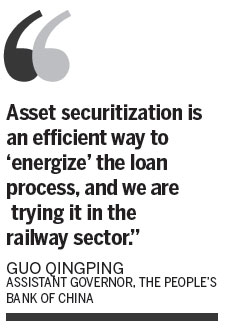 Large Medium Small
Large Medium SmallWith liquidity in China remaining generally abundant, there's renewed discussion about how financial resources can be distributed more efficiently.
"The real economy, especially manufacturers at the lower end of the value chain, are complaining about rising costs for raw materials, labor and other items," said Zhang Xiaoji, director of Foreign Economic Relations Development at the Development Research Center of the State Council.
Zhang, who's also a CPPCC member, said that more should be done to help the real economy gain easier access to financing.
The broad measure of money supply (M2), which covers cash in circulation and all deposits, expanded 13.6 percent to 110.65 trillion yuan ($19 trillion) in 2013, just 0.2 percentage point less than in 2012, according to the central bank.
While keeping macroeconomic policy stable, China made good use of both existing and additional monetary and financial resources, Premier Li Keqiang said in his government report.
As for the future, Guo Qingping, an assistant governor at the People's Bank of China, said the central bank will pay more attention to small and medium-sized enterprises to ensure that financial support is available to assist in the nation's economic transformation.
"Asset securitization is an efficient way to 'energize' the loan process, and we are trying it in the railway sector," said Guo.
"As long-term investments account for a big part of railway spending, we're making it a practice to turn the sector's loans into liquid assets that can be traded on the market," added Guo.

Guo said the central bank will promote asset securitization in more industries.
In contrast to many overseas markets, where securitization began decades ago, the process is still in its infancy in China.
Domestic asset securitization only began in March 2005. From that date through 2008, just 11 domestic financial institutions issued asset-backed securities worth 66.78 billion yuan, the PBOC said.
Meanwhile, there's concern about whether liquidity in China is only finding its way into limited sectors, such as manufacturing and infrastructure. SMEs, technology companies and the services industry are still hungry for cash.
Guo said that as interest rate reform continues, market forces will channel capital into sectors that are short of finance support.
Zhou Mubing, vice-chairman of the China Banking Regulatory Commission, said the government is focusing both on key economic fields and weak sectors, including agriculture, SMEs and railways.
In a bid to keep economic performance within a proper range, Li said the government will strengthen the coordination of fiscal and monetary policies with industrial and investment policies, maintain policy options and make adjustments at an appropriate time and to an appropriate degree.
"This year, M2 is forecast to grow by about 13 percent," said the government report.
yaojing@chinadaily.com.cn